Google has been structuring many of its new ad products and features around the discovery theme this year. Brad Bender, Google’s VP of Product Management, announced these new releases and updates are designed to reach people “not only when they are looking for something specific, but also when open to discovering something new” — which is critical for engaging passive browsers and attracting qualified traffic at the top of the funnel.
Prabhakar Raghavan, Google’s SVP of advertising and commerce explains further:
.In a world where we have less time and more options, it’s crucial for brands to anticipate what consumers need to stand out. People turn to Google to communicate, find answers, and stay entertained. And increasingly, they’re swiping and scrolling through feeds as part of that journey—whether it’s browsing videos in the YouTube home feed, checking timely offers in the Gmail Promotions tab or swiping through Discover to catch up on the latest news -- these are opportunities for brands to engage them when it matters
Google Discovery Ads fit this discovery theme precisely and help advertisers engage and attract qualified traffic at the top of the funnel.
What are Google Discovery Ads?
Discovery campaigns combine visually engaging ad formats and audience targeting features to better personalize the ad experience and inspire customer action. The visual ad format allows advertisers to showcase a single image or multiple images of their product or service:
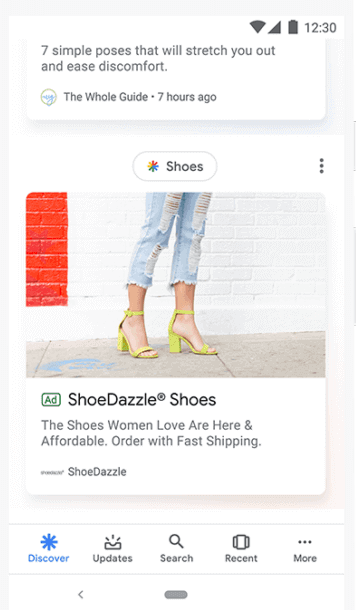
Targeting with Discovery Ads relies on audience targeting, rather than keyword-based search intent targeting. In fact, Bender describes the ads as “visually rich, mobile-first, and use the power of intent” where ‘power of intent’ means signals that Google derives from consumers’ previous behavior patterns (site visits, app downloads, videos watched, map searches, etc.). Essentially, the same signals Google uses for in-market audience targeting.
5 Most important things to know about Google Discovery Ads
When evaluating if this new type applies to your campaigns, consider the following points.
1. They have their own campaign type
First, you’ll need to run a separate Discovery campaign, which indicates just how important Google thinks these ads are.
They are similar to Universal App campaigns in that advertisers upload their creative assets and some copy ideas, and Google automatically handles optimization and delivery through machine learning (more on this in #4 below).
Since Discovery ads live primarily in feeds and not on search (more on this later), search intent doesn’t play a role. However, because you’re losing some commercial intent, your targeting strategy will be different. Custom intent audiences and in-market audiences are great options for this type of campaign because they’re highly focused on people in the discovery and/or research phase of the buying cycle.
In addition to a different targeting strategy, Discovery Ads also require you to take a different creative approach. Although these ads should show up in response to a user’s interests and behavior, there’s still no actual search intent — so be mindful of where your audience is on their buyer journey when creating content.
2. Lean into the discovery mindset
This is key to capitalizing on the new ad option because again, there’s no real search intent. What this does mean is, there is more pressure on advertisers to create persuasive headlines, descriptions, and visuals.
Similar to Facebook Carousel Ads, Discovery Ads allow advertisers to display one or more images that showcase their product or service in a slideshow format on the Discover feed (among other locations, discussed below).
While this might seem like Google’s attempt to partake in the news feed advertising game, Discovery Ads go much deeper. Users on the Discover feed are in learning and discovery mode, so it makes sense for advertisers to show ads that appeal to that mentality.
But, merely creating a carousel ad won’t guarantee you’re fully leaning into the discovery mindset, so you’ll want to also produce compelling and interesting content.
Rather than taking a direct selling approach, start by addressing common pain points and selling points. As you determine certain concepts produce the majority of your campaign results; you can refine your copy and visuals around those specific points.
Remember, these are Discovery Ads — so the purpose isn’t to sell a product, but rather to get people excited about discovering your business.
3. They’re not just for the Discover feed
The Google Discover feed is Google’s version of the Facebook feed, except powered by Google’s machine learning algorithms, which reaches 800 million people globally.
However, it’s not just this audience that advertisers reach, and the Discover feed is only one location where the ads show (on the iOS and Android Google app, and mobile Google.com).
They can also reach people on YouTube’s mobile home feed, displaying as native in-feed ads with large images and a CTA banner underneath:
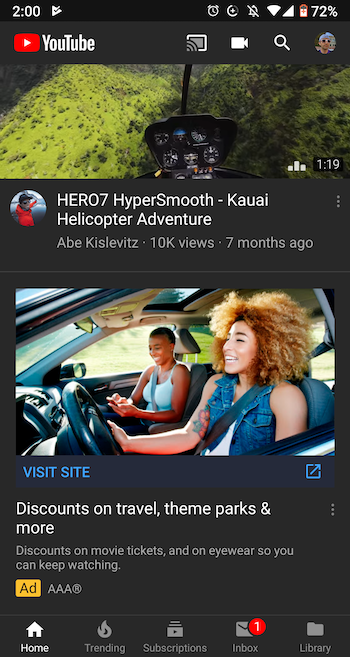
And in Gmail’s social and promotions tabs, looking and functioning similar to regular Gmail sponsored ads:
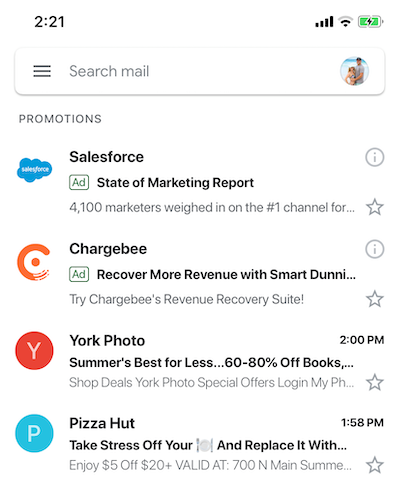
The idea here is that the Discovery Feed, YouTube, and Gmail are three specific places people go when they’re in learning and discovery mode. Ads that appear in these locations should perform well. In fact, 76% of consumers enjoy making unexpected discoveries when shopping, and 85% take product-related action within 24 hours of discovering a product.
Note: Regardless of location, Discovery Ads are charged on a CPC basis.
4. Machine learning plays a role
The whole point of Discover is that Google’s machine learning algorithms identify what users want and deliver it to them. Discovery Ads follow the same approach.
When setting up these ads, you’ll enter a landing page URL, at least one image, a logo, and up to five headlines and five descriptions. From there, Google’s machine learning serves the best combinations across the most relevant and appropriate placements — or where your audience is spending most of their time.
Depending on users’ account settings, Google may use web/app activity, device information, and location to personalize content (which is largely AMP enabled). For example, this ad was likely on my YouTube feed because of recent car shopping:
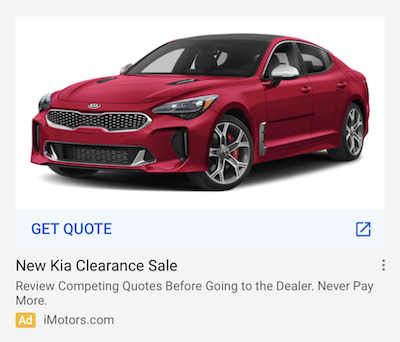
This one in the social tab of Gmail because I visited Hootsuite’s website earlier this week:
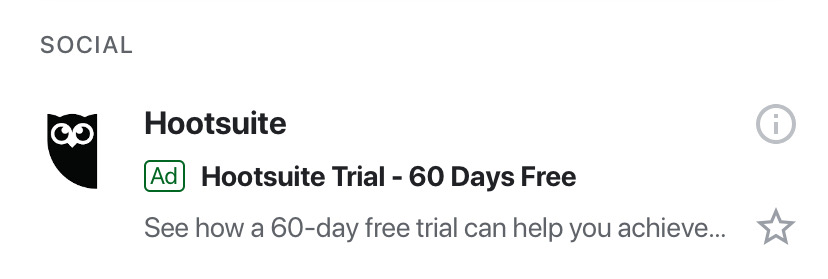
Just like Google’s Responsive Search Ads, this is yet another way Google is automating the ad optimization process to reach more relevant users with highly relevant creative and messaging.
Since Google’s machine learning algorithms have already been learning about what sort of content individual users respond to most, this should mean higher ad click-through and conversion rates.
5. Creative asset guidelines must be followed
People come to the Discover feed, YouTube home feed, and Gmail to browse and discover new content that aligns with their interests. To ensure ads feel both authentic and relevant, Google recommends you select high-quality imagery that tells your brand’s story.
In addition, all ad content must adhere to Google Ads Policy guidelines and Personalized advertising guidelines.
Ads that include any of the following will be disapproved:
- A CTA button in the image (or any visuals that mimic hyperlinks or look like clickable elements)
- Clickbait (intended to entice a user to click-through by suggesting they’ll find out something amazing, outrageous, or sensational)
- Blurry, low-quality images
- Poorly cropped images
- Images oriented incorrectly
Attract qualified traffic at the top of the funnel
Reaching people when they’re open to discovering something new is just as important as targeting them when they’re looking for something specific. After all, everyone starts at the top of the funnel at one time or another. The new Google Discovery Ads are perfect for engaging these passive browsers at the top of the funnel.
Learn about many other ad types and ad specs in the Instapage Ad Specs Guide here. It comes complete with dimensions, file formats, sizes, and everything to know to create the most compelling ads across all devices and platforms.
